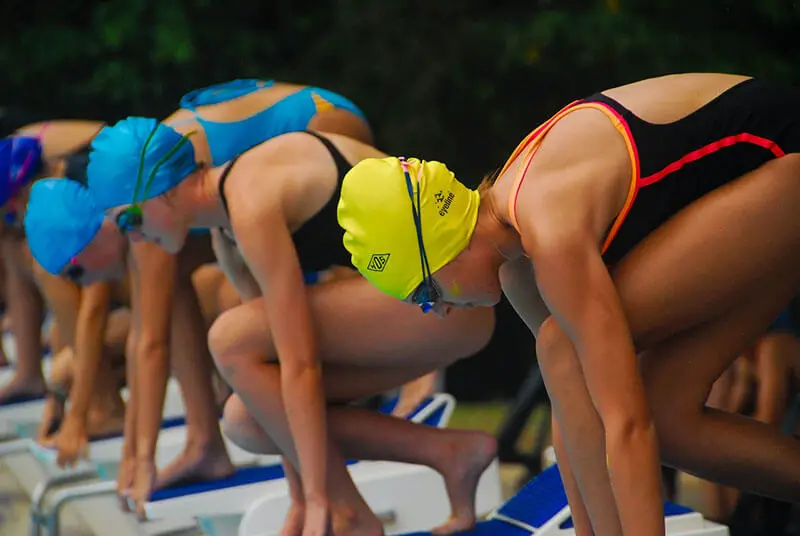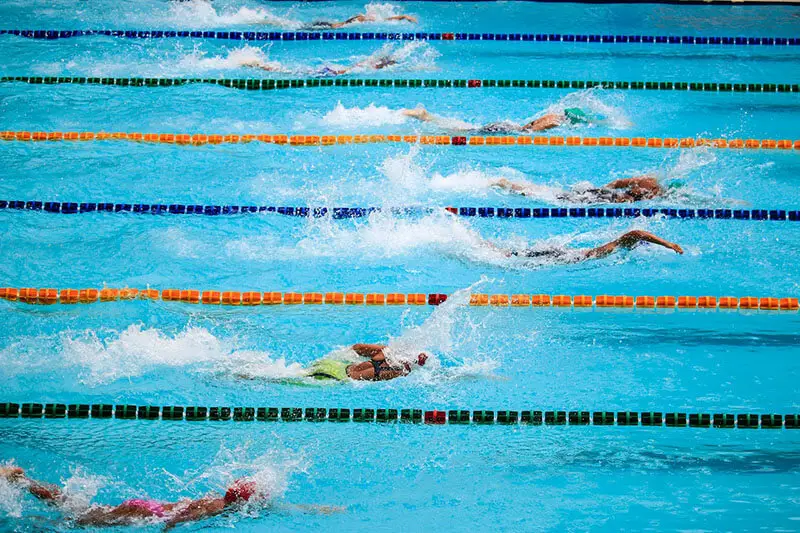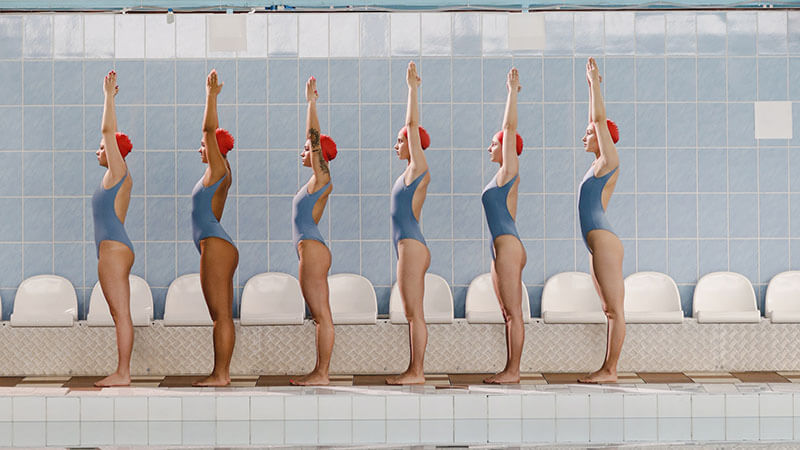Everyone loves a David and Goliath story. It’s always so inspiring to see the underdog get the better of their nemesis even though the odds are stacked against them.
When it comes to the highest level of competitive sports in the world, where upsets happen all the time, where better to look than the Olympic games?
Being a bit on the shorter side, I and many people have asked this question: who are the shortest Olympic swimmers that have won a medal in individual events?
Who are the men and women that, despite being vertically challenged, managed to overcome the odds and end up on the podium anyways?
The shortest male Olympic swimmer who won an individual medal is Brad Cooper who stands at a height of 160 cm (5’ 3”), and the shortest female Olympic swimmer who won an individual medal is Tineke Lagerberg who stands at a height of 153 cm (5′ 0”).
Besides these two amazing athletes, in this article I will list many more short Olympic swimmers that have at least won an individual medal at the Olympics. I also want to discuss how big of an impact height has in the sport of swimming.
Shortest Olympic swimmers that won a medal at individual events
Before I begin, I would like to give credit to SwimmingStats for providing the data I am about to share below. Be sure to check out their Twitter account and Facebook account and give them a follow for more interesting swimming stats.
Also, keep in mind these athletes won medals in individual events. This distinction is important so there can be no excuses made about their teammates carrying them to the podium – their successes were solo efforts.
Male swimmers
1960-2021 Data taken from this Facebook post:
| Name | Height | Country | Competition year(s) |
| Brad Cooper | 160 cm / 5’ 3” | Australia | 1972 |
| Ricardo Prado | 168 cm / 5’ 6” | Brazil | 1980-1984 |
| Tomomi Morita | 169 cm / 5’ 6” | Japan | 2004-2008 |
| Tsuyoshi Yamanaka | 171 cm / 5’ 7” | Japan | 1956-1964 |
| Kevin Berry | 172 cm / 5’ 8” | Australia | 1960-1964 |
| Vladimir Kosinsky | 172 cm / 5’ 8” | Soviet Union | 1964-1972 |
| Martyn Woodroffe | 172 cm / 5’ 8” | Great Britain | 1968 |
| Andrey Smirnov | 172 cm / 5’ 8” | Soviet Union | 1976 |
| Tomoru Honda | 172 cm / 5’ 8” | Japan | 2021 |
| Doug Russell | 173 cm / 5’ 8” | USA | 1968 |
| Nobutaka Taguchi | 173 cm / 5’ 8” | Japan | 1968-1976 |
| Brian Goodell | 173 cm / 5’ 8” | USA | 1976 |
| Tim McKee | 173 cm / 5’ 8” | USA | 1972-1976 |
| Neil Cochran | 174 cm / 5’ 9” | Great Britain | 1984-1988 |
| Daiya Seto | 174 cm / 5’ 9” | Japan | 2016-2021 |
Female swimmers
1960-2021 Data taken from this Facebook post:
| Name | Height | Country | Competition year(s) |
| Tineke Lagerberg | 150 cm / 4’ 11” | Netherlands | 1960 |
| Marianne Heemskerk | 152 cm / 5’ 0” | Netherlands | 1960-1964 |
| Satoko Tanaka | 158 cm / 5’ 2” | Japan | 1960-1964 |
| Michelle Ford | 159 cm / 5’ 3” | Australia | 1976-1980 |
| Kyoko Iwasaki | 159 cm / 5’ 3” | Japan | 1992-1996 |
| Elaine Tanner | 160 cm / 5’ 3” | Canada | 1968 |
| Roswitha Beier | 160 cm / 5’ 3” | East Germany | 1972 |
| Hannelore Anke | 160 cm / 5’ 3” | East Germany | 1972-1976 |
| Rosemarie Gabriel | 160 cm / 5’ 3” | East Germany | 1972-1976 |
| Samantha Riley | 160 cm / 5’ 3” | Australia | 1992-1996 |
| Michelle Smith | 160 cm / 5’ 3” | Ireland | 1988-1996 |
| Sharon Finneran | 161 cm / 5’ 3” | USA | 1964 |
| Rebecca Smith | 161 cm / 5’ 3” | Canada | 1976 |
| Suzie Landells | 162 cm / 5’ 4” | Australia | 1984 |
| Miki Nakao | 162 cm / 5’ 4” | Japan | 1996-2000 |
Analyzing the data
For the men, Brad Cooper seems to be the extreme outlier seeing as how there is an 8 cm / 3 inch gap between him and the second shortest male swimmer on that list.
As an aside, Cooper’s first ever medal at the Olympics was gold and it was a controversial win. The original gold medal winner was Rick DeMont, who stands at 6’ 2”, and he touched the wall just 0.01s ahead of Cooper.
Unfortunately, being an asthmatic, DeMont tested positive for the banned drug ephedrine found in his asthma drug Marax and was subsequently disqualified. Cooper was awarded the gold instead.
At the very least, this is evidence to suggest that a swimmer nearly an entire foot shorter than another competitor can have a close race despite the height disadvantage.
For women, there are two outliers: Tineke Lagerberg and Marianne Heemskerk, both representing the Netherlands and both competing at the 1960 Olympic games. They are also 2-3 inches shorter than the next shortest female swimmer in the list.
Without these outliers, the shortest swimmers on either list would have been around 3 inches taller, so it could be the case that these athletes were simply exceptional for their height.
Also of note are the years most of these athletes competed in. There are very few short modern swimmers (e.g. from the year 2000 onwards), as most of these shorter athletes saw success in the 60’s and 70’s.
But it seems that in recent decades taller swimmers have been dominating swimming events at the Olympics.
Average height of swimmers in modern times

To give more perspective on how incredible it was that these athletes did as well as they did, did you know that in 2016 the average height of an Olympic swimming finalist was 188 cm (6’ 2”) for men, and 175 cm (5’ 9”) for women?
That is approximately 5 inches taller than the average height of Americans for their respective genders.
We could say that these athletes achieved their success due to training and hard work, but it does make one wonder whether their above average height also gave them an advantage over the competition.
In fact, the two most accomplished swimmers in recent times are Michael Phelps and Katie Ledecky, both Americans.
Michael Phelps needs no introduction, as he is literally the greatest Olympian of all time with an unparalleled 28 medals to his name. He also stands at 193 cm (6’ 4”) with a 201 cm (6’ 7”) wing span.
Katie Ledecky is also incredibly decorated in her own right, with an impressive 10 Olympic medals to her name (this only looks unimpressive next to Michael Phelps, but it’s absolutely insane compared to most other athletes). She happens to stand at 183 cm (6’ 0”) tall.
Two incredible modern athletes, both are even taller than the average height of swimmers, so it begs the question: maybe their height has something to do with their success?
Unfortunately for shorter swimmers, things aren’t looking too good. And there is a very good explanation for why taller swimmers have a huge advantage (literally).
Why taller swimmers tend to beat shorter swimmers

Unfortunately, this is not the narrative shorter people want to hear, but reality is often harsh and disappointing.
There are two main considerations: the length of one’s body from head to toe, and how large their hands and feet are.
There is evidence to support the claim that being taller gives one an advantage at swimming. Essentially, researchers found that the longer one’s body is, the less drag they experience underwater.
Assuming two swimmers are moving at the same speed but one swimmer is taller than the other, then the taller swimmer will experience less drag than the shorter one.
In other words, a shorter swimmer needs to expend more energy to overcome the drag they experience, causing them to tire more quickly.
Second, longer and larger hands and feet also provide an advantage for swimming. Have you ever tried swim fins or hand paddles? They help you swim faster by letting you pull more water per kick/stroke, helping you achieve greater velocity.
Well if you have bigger hands and feet than your competition, it’s like you naturally are wearing swim fins or hand paddles all the time compared to someone with smaller hands/feet.
The silver lining for shorter swimmers
So is it time for shorter swimmers to pack it up and give up on their dreams of standing on that podium? Not so fast.
John Mullen of swimmingscience.net wrote an interesting article that has since been removed, but an archived page still exists.
He looked at the finalists of the Men’s 200 Free at the 2014 Asian Games, and he did some calculations to determine what their energy expenditure would have been like.
These were his results:
| Swimmer | Height | Time | Total kcal |
| Kosuke Higano | 5’ 9” | 1:45.23 | 21.89 |
| Sun Yang | 6’ 6” | 1:45.28 | 28.82 |
| Park Tae-Hwan | 6’ 0.5” | 1:45.85 | 24.21 |
First, this race was certainly a nail-biter.
Second, the shortest swimmer of the three expended the least amount of energy, whereas the tallest swimmer expended the most energy. There seems to be a correlation between height and energy expenditure.
This seems to contradict the previous finding which suggested that shorter swimmers would experience more drag and therefore require more energy to maintain the same pace as a taller swimmer.
However, both findings can be technically true:
- A taller swimmer expends more energy to move his larger body through the water where he meets less drag.
- A shorter swimmer expends less energy to move his smaller body, but needs to expend additional energy to compensate for the increased drag he experiences.
Overall, perhaps all of these pros and cons result in a wash.
Or, perhaps it may even favor the shorter swimmer after all (at least in terms of energy expenditure), giving them an advantage for longer races.
Whatever the case, it is clear that shorter swimmers can sometimes take the win against taller swimmers even in recent decades.
Unfortunately, it does seem that the floor for a medal-winning swimmer’s height is increasing, but who knows when the next short swimmer will dominate the Olympic games and prove everyone wrong.

